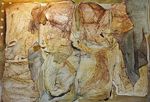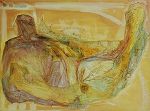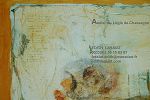EDITH LASSIAT 
EDITH LASSIAT |
Critics
Critic by Adriaan Himmelreich, Maastricht, January 2006 (Author and art critic) Edith Lassiat's works strike us by the power of fragileness of their surfaces, pigments and forms, which seem to find their origins in the soul of mankind and the earth itself. They form a continuous effort to transcend knowledge, ranging from one's own body and the techniques to live one's life, to the traces of man's search for truth and beauty. Lassiat's works, all of them realized with earth pigments, appear to us as a permanent unfolding of light, which material is generally considered as being the origin and basic condition of life. Fragments of images and handwritten texts are organically integrated within a game of opaque and translucent layers. Developed in series, the paintings and paper works, all realized in human formats, read as a "journal intime", a personal diary, imposing a respectful distance and intensive view at the same time. Each individual piece evoke an intimacy reminding us of late medieval "Andachtsbilder" small scale religious images meant for private devotion. Still, the works of Edith Lassiat cannot be interpreted without regarding them as parts of a whole, which can neither be known nor named. Each work, each series, form an ongoing process in which the artist captures „slicesš of life's creation, which is an ongoing process by itself. She does not re-present, but presents elements of life through its very materialness (i.e. the act of creating works). The seductive quality of these works is based on their fragmented character and the relative space of time in which they came to life. It is through this generous illusion, that Lassiat‚s works impose their realities among the realities around. Critic by Christian Gattinoni, Paris, June 2004 (Author and art critic) Silence, absolute silence of a painted desire… There is risk in this Art, despite the obvious immediate seduction and serenity which come out of the texture and the rich colour range. The stake can be seen as following: How to link a successful post-Rothko inspiration, in terms of "colour-texture", to the introduction of a sophisticated and almost disappearing calligraphy erased like a palimpsest*. And as to make these challenge even more difficult, icons of the past, angels, or baroque images enrich these works. The show skilfully combines works on paper and canvasses of different sizes. The exhibition is organized as an opera with melodic variations around the major theme, through a succession of larger or smaller works like an aria and its complementary pieces. The mixed media works on Japanese paper ought to be discovered as different supplement supports to the scenographic ensemble. The recent light blue works full of meditation like a whisper are in opposition with the earlier flesh coloured silent ones… …With all these mastered contradictions, this painting develops energy full of desire which takes you much further than the colours and icons themselves. All these works are about an exigency of live and create. *palimpsest: writing material (as a parchment) used one or more times after earlier writing has been erased. Who is Edith Lassiat? by Patrick X. Poisson - M.D., International Private Collector Painter, writer, President of exporevue (European contemporary art magazine on line and art-gate since 1998), and art critic, she also contributes to the development of the Museum for Trompe-l'Oeil (Trick-the-eye) in Périgueux (France). Her passion for art and communication lead her to a diversified path career. At 21, graduated from Ecole Supérieure de Commerce de Lille, she began an international career, and started to travel around the world as a Marketing Director for international groups (Cartier, YSL...). This allowed her to an intimate understanding of different cultures and ability to deal with group projects.She worked in Europe, America, Asia, and Africa, lived in New York, and spent a year in South America. After a master in management, she decided to start to focus herself on her original passion, Art and writing. In 1994, she plunged herself into the secrets of the Renaissance Ateliers, where she studied traditional work of the artist, works a tempera, a fresca, respect for production, and elementary gestures, and she started a study of Ancient Masters who still deeply inspire her, and abstraction and conceptual art. Techniques such as glazes, fresco and tempera, lead her to a deep feeling for texture, and helped her to develop her eye and sensitivity. The materials she uses are delicate (thin or recycled papers, gold and silver leaves...), sensual, vibrant, and give to her works a semi-transparent touch, like living membranes or parchments. She uses images as archetypal memories of collective unconscious and calligraphy. She is beset by profound religious and philosophical concerns with which she struggles throughout her works to translate into visual form. Her search is about the spiritual feeling rooted in every human being and quite influenced by the sensuality of ancient masters, by oriental calligraphy and its vision of emptiness and silence. Her art speaks of our unfulfilled spiritual yearnings, of a quest for the infinite and universal that persists today as it did thousands of years ago. She invites viewer to travel in himself and his own questions about life and death. She takes us "beyond the visible"… "Beyond the visible…" Her Works are full of sensuality and spirituality. Elegant and refined calligraphies, in smaller or larger sizes, virgins and angels: all of them underlied by a search for seeking and revealing what hides behind the images. Religious and Masonic icons are the centre of her works, but always diverted through texts or symbols inspired by the Tao or Greek philosophers, in order to let them say something else, something more… "Let us look behind the image", let us open our minds, hearts and souls, her works say… "Think different, see behind the mirror" The soft, silky paper she uses to tell her stories on wood or canvas replaces the drawing, which would be more obvious, less allusive, and leave less space to accident and expression of subconscious.This leads her to "a narrative technique bringing a kind of fragility, lightness, delicacy"All terms which qualify her works, which are though powerful due to the use of strong colours (like a deep red for her virgins) or dark wooden frames which contrast with the immaculate whites of her calligraphies mounted on transparent glass. "About angels" means "about inspiration",Inspiration: this very moment when, the artist, forgetting about himself, about his Ego, fills this large space inside with emptiness, in order to welcome something larger, deeper, and more subtle too, something fragile, requiring humility. Like a tiny voice from inside, a slight move which the body can echo…Only then, his ability to paint, to organise the space, to build the work becomes useful, only then. Artist and actor through letting go… Her Art is a permanent search for the borderline drawn between visible and invisible, between light and shadow, purity and desire… she expresses a duality and a permanent complexity which have ever been the very ones of the Human Being. |     |